Related Research Articles

A quark is a type of elementary particle and a fundamental constituent of matter. Quarks combine to form composite particles called hadrons, the most stable of which are protons and neutrons, the components of atomic nuclei. All commonly observable matter is composed of up quarks, down quarks and electrons. Owing to a phenomenon known as color confinement, quarks are never found in isolation; they can be found only within hadrons, which include baryons and mesons, or in quark–gluon plasmas. For this reason, much of what is known about quarks has been drawn from observations of hadrons.

Pegasus is a constellation in the northern sky, named after the winged horse Pegasus in Greek mythology. It was one of the 48 constellations listed by the 2nd-century astronomer Ptolemy, and is one of the 88 constellations recognised today.
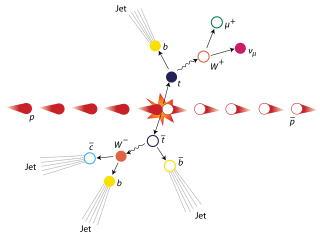
The top quark, sometimes also referred to as the truth quark, is the most massive of all observed elementary particles. It derives its mass from its coupling to the Higgs Boson. This coupling yt is very close to unity; in the Standard Model of particle physics, it is the largest (strongest) coupling at the scale of the weak interactions and above. The top quark was discovered in 1995 by the CDF and DØ experiments at Fermilab.
51 Pegasi, formally named Helvetios, is a Sun-like star located 50.6 light-years from Earth in the constellation of Pegasus. It was the first main-sequence star found to have an exoplanet orbiting it.

Michel Gustave Édouard Mayor is a Swiss astrophysicist and professor emeritus at the University of Geneva's Department of Astronomy. He formally retired in 2007, but remains active as a researcher at the Observatory of Geneva. He is co-laureate of the 2019 Nobel Prize in Physics along with Jim Peebles and Didier Queloz, and the winner of the 2010 Viktor Ambartsumian International Prize and the 2015 Kyoto Prize.

Hermann Carl Vogel was a German astrophysicist. He was born in Leipzig, Kingdom of Saxony. From 1882 to 1907 he was director of the Astrophysical Observatory, Potsdam. He made extensive discoveries using spectral analysis of the stars.

Didier Patrick Queloz is a Swiss astronomer. He is the Jacksonian Professor of Natural Philosophy at the University of Cambridge, where he is also a fellow of Trinity College, Cambridge, as well as a professor at the University of Geneva. Together with Michel Mayor in 1995, he discovered 51 Pegasi b, the first extrasolar planet orbiting a Sun-like star, 51 Pegasi. For this discovery, he shared the 2019 Nobel Prize in Physics with Mayor and Jim Peebles. In 2021, he was announced as the founding director of the Center for the Origin and Prevalence of Life at ETH Zurich.

The Underground Area 2 (UA2) experiment was a high-energy physics experiment at the Proton-Antiproton Collider — a modification of the Super Proton Synchrotron (SPS) — at CERN. The experiment ran from 1981 until 1990, and its main objective was to discover the W and Z bosons. UA2, together with the UA1 experiment, succeeded in discovering these particles in 1983, leading to the 1984 Nobel Prize in Physics being awarded to Carlo Rubbia and Simon van der Meer. The UA2 experiment also observed the first evidence for jet production in hadron collisions in 1981, and was involved in the searches of the top quark and of supersymmetric particles. Pierre Darriulat was the spokesperson of UA2 from 1981 to 1986, followed by Luigi Di Lella from 1986 to 1990.
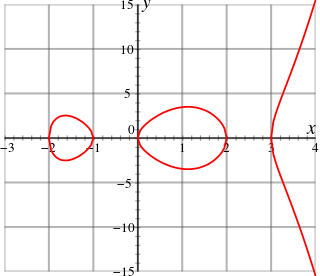
In mathematics, arithmetic geometry is roughly the application of techniques from algebraic geometry to problems in number theory. Arithmetic geometry is centered around Diophantine geometry, the study of rational points of algebraic varieties.
This is a timeline of subatomic particle discoveries, including all particles thus far discovered which appear to be elementary given the best available evidence. It also includes the discovery of composite particles and antiparticles that were of particular historical importance.
ELODIE was an echelle spectrograph installed on the 1.93m reflector at the Observatoire de Haute-Provence in south-eastern France. Its optical instrumentation was developed by André Baranne from the Marseille Observatory. The purpose of the instrument was extrasolar planet detection by the radial velocity method.

Upsilon Andromedae b, formally named Saffar, is an extrasolar planet approximately 44 light-years away from the Sun in the constellation of Andromeda. The planet orbits its host star, the F-type main-sequence star Upsilon Andromedae A, approximately every five days. Discovered in June 1996 by Geoffrey Marcy and R. Paul Butler, it was one of the first hot Jupiters to be discovered. It is also one of the first non-resolved planets to be detected directly. Upsilon Andromedae b is the innermost-known planet in its planetary system.

IK Pegasi is a binary star system in the constellation Pegasus. It is just luminous enough to be seen with the unaided eye, at a distance of about 154 light years from the Solar System.
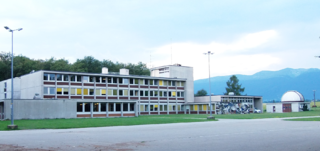
The Geneva Observatory is an astronomical observatory at Sauverny (CH) in the municipality of Versoix, Canton of Geneva, in Switzerland. It shares its buildings with the astronomy department of the École Polytechnique Fédérale de Lausanne. It has been active in discovering exoplanets, in stellar photometry, modelling stellar evolution, and has been involved in the European Space Agency's Hipparcos, INTEGRAL, Gaia, and Planck missions.
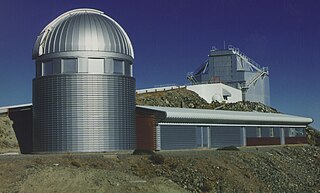
Leonhard Euler Telescope, or the Swiss EULER Telescope, is a national, fully automatic 1.2-metre (47 in) reflecting telescope, built and operated by the Geneva Observatory. It is located at an altitude of 2,375 m (7,792 ft) at ESO's La Silla Observatory site in the Chilean Norte Chico region, about 460 kilometers north of Santiago de Chile. The telescope, which saw its first light on 12 April 1998, is named after Swiss mathematician Leonhard Paul Euler.
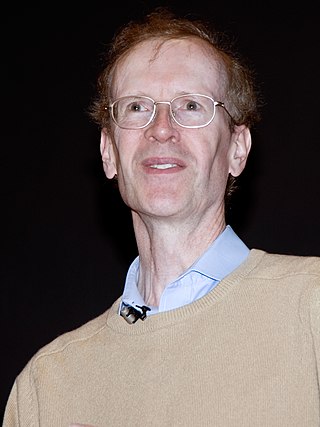
Wiles's proof of Fermat's Last Theorem is a proof by British mathematician Andrew Wiles of a special case of the modularity theorem for elliptic curves. Together with Ribet's theorem, it provides a proof for Fermat's Last Theorem. Both Fermat's Last Theorem and the modularity theorem were believed to be impossible to prove using current knowledge by almost all current mathematicians at the time.

51 Pegasi b, officially named Dimidium, is an extrasolar planet approximately 50 light-years away in the constellation of Pegasus. It was the first exoplanet to be discovered orbiting a main-sequence star, the Sun-like 51 Pegasi, and marked a breakthrough in astronomical research. It is the prototype for a class of planets called hot Jupiters.
Ann Heinson is an American high-energy particle physicist known for her work on single top quark physics. She established and led the DØ Single Top Group which first published experimental observations of the top quark, and in 1997 she co-authored a paper which laid the foundations for further investigation into the top quark.
WASP-79b, also known as Pollera, is an extrasolar planet orbiting the star CD-30 1812. This planet is in the constellation Eridanus, and is about 810 light-years from Earth.
References
- ↑ Mayor, Michael; Queloz, Didier (1995). "A Jupiter-mass companion to a solar-type star". Nature . 378 (6555): 355–359. Bibcode:1995Natur.378..355M. doi:10.1038/378355a0. S2CID 4339201.
- ↑ "A Near-Earth Object Hazard Index" presented at a United Nations conference and published in its proceedings, Annals of the New York Academy of Sciences , 822 (1997).
- ↑ "Spitzer Telescope Observes Baby Brown Dwarf". Jet Propulsion Laboratory .
- ↑ Halder, G.; Callaerts, P.; Gehring, W. J. (1995). "Induction of ectopic eyes by targeted expression of the eyeless gene in Drosophila". Science. 267 (5205): 1788–1792. Bibcode:1995Sci...267.1788H. doi:10.1126/science.7892602. PMID 7892602.
{{cite journal}}: CS1 maint: multiple names: authors list (link) - ↑ Hansard, Carolyn. "Introduced Species Summary Project Sudden Oak Death (Phytophthora ramorum)". Columbia University.
- ↑ Lewis, Peter H. (31 January 1995). "COMPANY NEWS; Prodigy Sees Quick Growth from Internet Web Service". The New York Times.
- ↑ "Cybertelecom :: NSFNET". cybertelecom.org.
- ↑ Lerdorf, Rasmus (1995-06-08). "Announce: Personal Home Page Tools (PHP Tools)". Newsgroup: comp.infosystems.www.authoring.cgi . Retrieved 2012-06-08.
- ↑ "History & Timeline" . Retrieved 2012-07-02.
- ↑ Byers, Ann (2006). Jeff Bezos: the founder of Amazon.com. The Rosen Publishing Group. pp. 46–47. ISBN 9781404207172.
- ↑ Wiles, Andrew (1995). "Modular elliptic curves and Fermat's Last Theorem" (PDF). Annals of Mathematics. 141 (3): 443–551. CiteSeerX 10.1.1.169.9076 . doi:10.2307/2118559. ISSN 0003-486X. JSTOR 2118559. OCLC 37032255. Zbl 0823.11029. Archived from the original (PDF) on 2011-05-10. Retrieved 2013-05-15.; Taylor, Richard; Wiles, Andrew (1995). "Ring-theoretic properties of certain Hecke algebras" (PDF). Annals of Mathematics. 141 (3): 553–572. CiteSeerX 10.1.1.128.531 . doi:10.2307/2118560. JSTOR 2118560. OCLC 37032255. Zbl 0823.11030. Archived from the original (PDF) on 2017-03-09. Retrieved 2013-05-15.
- ↑ "HIV Surveillance --- United States, 1981--2008". Archived from the original on November 9, 2013. Retrieved November 8, 2013.
- ↑ Abe, F. et al (CDF Collaboration) (1995). "Observation of Top Quark Production in
p
p
Collisions with the Collider Detector at Fermilab". Physical Review Letters . 74 (14): 2626–2631. arXiv: hep-ex/9503002 . Bibcode:1995PhRvL..74.2626A. doi:10.1103/PhysRevLett.74.2626. PMID 10057978. S2CID 119451328. - ↑ Abachi, S. et al (DØ Collaboration) (1995). "Search for High Mass Top Quark Production in
p
p
Collisions at √s = 1.8 TeV". Physical Review Letters. 74 (13): 2422–2426. arXiv: hep-ex/9411001 . Bibcode:1995PhRvL..74.2422A. doi:10.1103/PhysRevLett.74.2422. PMID 10057924. S2CID 119392677. - ↑ Liss, T. M.; Tipton, P. L. (1997). "The Discovery of the Top Quark" (PDF). Scientific American . 277 (3): 54–59. Bibcode:1997SciAm.277c..54L. doi:10.1038/scientificamerican0997-54.
- ↑ Loftus, E. F.; Pickrell, J. E. (1995). "The formation of false memories" (PDF). Psychiatric Annals. 25 (12): 720–725. doi:10.3928/0048-5713-19951201-07. Archived from the original (PDF) on 2008-12-03. Retrieved 2011-02-27.
- ↑ SampTA1995 Sampta95 link